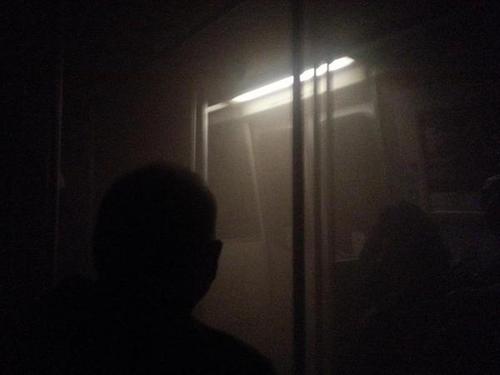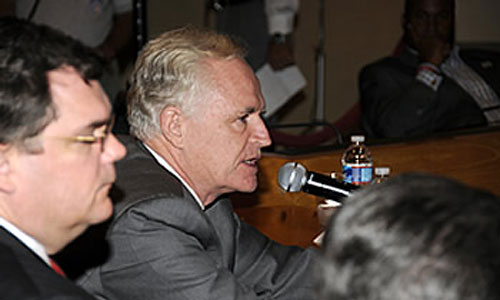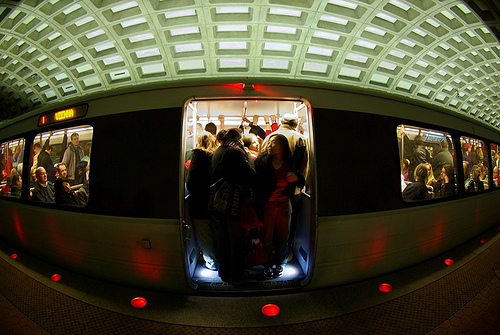The five most frustrating things about Metro’s problems

Photo by thisisbossi on Flickr.
For a few years after the 2009 Fort Totten Red Line crash, public confidence in Metro’s safety was growing. But a smoke fatality in January, a scathing federal report, and hearings last week have put safety back into the spotlight.
I talked about Metro’s safety on the Kojo Nnamdi Show last Monday, with guest host Jen Golbeck and Greater Washington Board of Trade head Jim Dinegar. Wednesday, I talked with Mike Coneen on NewsTalk with Bruce DePuyt after the first day of hearings.
During the first day, details emerged that the operator of the train in the smoky tunnel wanted to pull the train back out, but was told to wait.
A train behind it had already come into the station, and police decided to evacuate that train, which made it impossible to move it out of the way to make room for the train in the tunnel. There didn’t seem to be a clear response plan for this kind of situation or someone in charge who could coordinate all of the first responders.
After the Fort Totten crash, it became clear that the Tri-State Oversight Committee (TOC), a group of safety officials from DC, Maryland, and Virginia tasked with monitoring safety, wasn’t functioning well. Reforms supposedly set it up to succeed.
Apparently not, though. We discovered that the TOC wasn’t able to issue many recommendations because it had to wait for higher-ups in DC, Maryland, and Virginia to agree, and then when it did, WMATA often didn’t follow up.
WMATA and regional governments need to quickly address not only the specific failures of the L’Enfant incident, but also deal with the bigger picture issues. A few things stick out as frustrating for riders.
1. Reforms around safety haven’t fixed safety.
After the crash, some people argued that the WMATA Board had focused too much on service and neglected safety. Under political pressure, many long-serving board members resigned or were replaced. Instead of elected officials, who’d been more focused on what was frustrating riders, the board got a new crop of transit experts like current chairman Mort Downey and last year’s chairman Tom Downs.
They brought in an old friend and old grizzled transit veteran, Rich Sarles, to be general manager. They said his experience should help get WMATA on a solid footing of safety and otherwise maintain a firm hand on the wheel. But it doesn’t really look like the safety culture is so solid after all.
WMATA has other issues to deal with, too. Customer service is often pretty poor, and the agency is secretive not just with safety information but a lot more as well. It was pretty clear that Sarles was not the man to reform these aspects of the agency, but arguably getting a rock-solid safety foundation first was most important, and then Sarles’ successor could tackle other needs. That’s not possible now.
2. Replacing the board didn’t fix financial oversight, either.
WMATA also didn’t follow procurement laws properly, which led the Federal Transit Administration to put WMATA in a “penalty box.” WMATA now can’t get its federal money until after it’s spent it, creating a cash crunch.
Transit experts disagree on how much of an immediate crisis this represents — Downey and other insiders say it’s just a short-term cash flow problem, while some, like DC CEO Jeffrey DeWitt, warn about WMATA being unable to repay its bonds.
Either way, however, it’s maddening that this situation arose at all. As with safety, there was a whole push to get “experts” on the board of directors. Where were they?

Surprise image from Shutterstock.
3. All of these problems came as a surprise.
There were people who knew that these safety issues and financial issues created risks, but the public didn’t, and neither apparently did many board members. The Inspector General was sounding the alarm on some of these problems, but IG reports tend to be opaque if they’re even public.
This is just like what happened with the Fort Totten crash, where there were people aware the track circuits weren’t working, but they didn’t share that information widely enough. It’s not okay to have a culture of hiding problems from superiors. It’s not okay to hide this kind of information from policy-makers and the public, either.
Riders aren’t so stupid that they can’t be trusted to know about the various safety efforts underway. People know about the risks of roads and still drive. It’s worse for the agency’s reputation to have kept safety and financial pitfalls a secret and more disturbing when they then come to light.
4. Underfunding is a problem, but it’s hard to fix now.
These management problems are infurating, but mismananagement is only half of the problem. Underfunding is the other half. WMATA didn’t get enough money over decades to keep up with repairs, and now has to contend with a huge backlog.
The radios weren’t working during the L’Enfant incident, which is inexcusable, but it would be a lot easier to criticize the agency for not fixing its radio systems if it hadn’t been trying to fix the track circuits and a zillion other pieces, all of which work well enough day-to-day but might contribute to a safety problem at some point.
Unfortunately, it’s even harder to get that funding when the news is so bad. Congress is planning to cut in half the money it promised for repairs after the 2009 crash. A lot of this might just be ideological opposition to transit from conservative members, but all of these problems, and the lack of honesty in the past, sure don’t help.
5. We need Metro to not only thrive, but grow.
Metro ridership has stopped growing, but it’ll pick up again, and we need to be planning now to deal with the capacity crunches. Metro needs 8-car trains, but now the region won’t buy enough railcars to make it possible, let alone upgrade power systems and add yard space.
Metro needs to solve the bottleneck at Rosslyn which now limits the number of Blue Line trains and will only get worse in the future.
Two years ago, we were talking about the Momentum plan to deal with Metro’s needs first for 2025 and then beyond. Today, sadly, there isn’t much momentum at all.
Which is sad, because Metro still is a very valuable transportation system. Our region depends on it — there isn’t enough road space, or parking space, for all of the commuters otherwise. And it’s actually quite a speedy way to get around, when it works and when you’re going somewhere near a station.
We can’t afford to let Metro stagnate or decay. Sadly, it turns out we didn’t make nearly as much progress over the last six years as we thought.
You can listen to the Kojo segment here and watch the NewsTalk video below:



